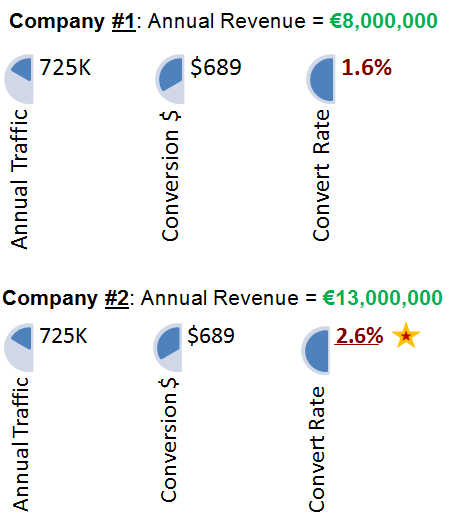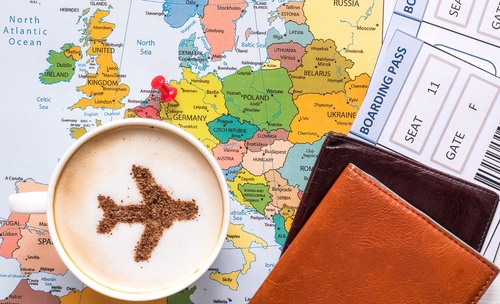Increase Travel Website Conversion Rates with Common Sense
By David Eddy on Nov 24, 2015 7:00:00 AM

The Web can be a magical place: your company launches its website and over the course of weeks and months transactions begin to take place with people you’ve never heard of, from places you’ve never been. Soon you find yourself spending long hours exploring ways to build site traffic: SEO concepts and terms from Google analytics become a familiar part of your vocabulary. After months of steady effort momentum builds and a steady upward trend emerges. But not so for sales; revenue consistently lags behind projections. An inbound marketing firm is brought in and reports the conversion rate for website traffic is 1.5% - and calls it good news because it’s so close to the travel industry average of 1.6%. It sure doesn’t seem like good news, does it?
A Closer Look at Conversion Rates
What’s a conversion rate? For the majority of those reading this article, the first answer that pops into their head is turning website visitors into product/service buyers. It’s a good answer – almost every article on conversion analytics agrees. But it’s a limited answer. Perhaps a more useful answer is “the conversion rate is the percentage of users who take a desired action”, because – while a purchase is unquestionably the most desirable conversion, there could be other related conversions worth taking into account. 
In fact, effective conversion strategies will build on interim, non-transactional, conversion steps that lead to the definitive conversion into a customer. Such steps often include: call-to-actions, the moment when a visitor exchanges an email address for downloadable material; or a sign-up for a monthly or quarterly newsletter. Any step that converts an anonymous visitor into a relationship is invaluable in the overall conversion process.
Using the visitor-to-buyer definition, what’s a reasonable travel website conversion rate goal? In the preceding example, the average travel industry conversion rate actually is 1.6% - but the conversion rate for the top 20% performers is 2.6%.
On the other hand, abandonment rates – defined as visitors leave shopping carts behind - for travel websites is high: 74% according to SalesCycle, as opposed to 71% for ecommerce as a whole. Keep in mind; these percentages don’t include browsers who leave without creating a shopping cart at all.
Many factors beyond the website itself influence conversion rates, so time spent analyzing the rate before planning how to increase it is always a good idea. For example, if a conversion rate is below the industry average – but the associated transaction size is above the average, that tradeoff could be a good thing. Smart phones and tablets produce much lower conversion rates than laptops or desktops, so if your traffic skews in the direction of those devices the aggregate rate could be deceptively low.
Common Sense Goal-Setting
When it comes to setting goals for improving conversion rates, one of the toughest obstacles is psychological: it just doesn’t seem possible so many people leave the website without buying! There must be some simple explanation.
This can lead people to chase after unreasonable goals with the wrong tools – roughly akin to an 18th century treasure hunter armed with a semi-accurate map. An example is very high conversion targets tied to AB testing of stylistic site enhancements. It’s not difficult to find sites promising double digit conversion rates from new page layouts or color schemes.
AB testing is a valid methodology. Every website should employ it before major site changes are set in stone. In fact, there’s no reason not to include conversion related changes as well. But it should not be foundational for two reasons: its short-term accuracy can be misleading and lead to wrong conclusions; wrong conclusions can be expensive if they actually lower conversions.
The weakness of AB testing in conversion work is in plain sight: limited, short-term, sample sizes. Results from the first day of AB testing is based on a 1/365 sample (approximately) of the site’s annual traffic. Since the test splits traffic, each option – A or B – is exposed to a 1/730 sample of annual traffic. Typically, results tend to normalize as testing days and sample sizes increase. This means a initially impressive jumps in conversion rates can melt away to inconsequence over sixty or ninety days; putting the conversions back to where they were, minus the lost time.
No one can argue against the value of large jumps in conversion rates, but goal setting doesn’t require them. Any site with good traffic will benefit enormously from what might appear to be minor improvement. To illustrate this point, take the travel websites of Company A and  Company B. Both sites have the same traffic – 750K visitors annually; match the industry average transaction size - $689 and the industry average conversion rate – 1.6%. As a result, both companies generate €8,000,000 in annual revenue.
Company B. Both sites have the same traffic – 750K visitors annually; match the industry average transaction size - $689 and the industry average conversion rate – 1.6%. As a result, both companies generate €8,000,000 in annual revenue.
Here’s where the companies diverge: Company A pursues an “AB testing; big conversion spike” strategy and winds up back at 1.6%. Company B pursues a “series of incremental, integrated, changes” and winds up with an ongoing 1% conversion rate elevation. What difference did a 1% change in conversion rate make? Company B increased its annual revenue to €13,000,000 - €5,000,000 more than Company A!
The point of this illustration is to demonstrate why goal-setting should be based on four common sense website traffic principals:
- People don’t like to feel lost or out of control. If they do, they will leave.
- Being asked for personal information makes people feel uncomfortable. Uncomfortable visitors leave.
- Being asked for payment information can be threatening to people. Threatened visitors leave.
- Despite all plans and efforts, most people will still leave. Every site must accept this reality and have a travel website abandonment strategy.
Steps to Reach those Goals
Abandonment: it will always rain and website visitors will always leave. Just as there is a roof over a house, your website must have an abandonment strategy. If it does, review and optimize it. If it doesn’t, there is no higher conversion plan priority.
The website must be responsive – able to display effectively in all devices. The digital revolution is rapidly moving web traffic from laptops/desktops to tablets and smart phones. Without a responsive travel website, travel companies will literally wastes a major segment of traffic by looking and functioning like 2012 on a tablet or phone.
A clean, articulate, search/result is essential. Always remember, search/result is the feature difference between travel sites and all other ecommerce sites. It must effectively communicate. Visitors aren’t required to search on retail sites; they can browse if they wish. Everyone searches on travel sites – no exceptions. If the search/result experience isn’t competitive, people leave.
Clean, clear, landing pages: once search/result is clean and effective, review all landing pages for similar clarity and economy. Accept that someone will always get lost or confused. Compensate with friendly features like FAQs and/or instant chat. Lost and confused people will never convert.
All forms must be simple. Every travel website faces this dilemma: it must know something about a visitor in order to personalize; but people get uncomfortable answering personal questions. At a certain point they leave. Since that point is unique for each visitor, simple forms are the only possible approach. Forms and questions should be inventoried on a spreadsheet, then simplified or eliminated.
Be a friend: if the site knows the visitor, it should act like it. Did they visit before and search for Paris flights and hotels? All submitted information and search criteria should be auto-filled on the next visit. Relevant suggestions and recommendations should personalize pages. Did they also download, “The Savvy Travelers Guide to Paris & London?” and provide an email address? That same day, Paris discount offers should appear in their inbox - with a link back to the site.
Finally, these steps – or other common sense actions – won’t succeed unless they are turned into plan, the plan is executed and milestones are evaluated. Increasing conversion rates isn’t an easy process, but the benefits will be substantial.
- travel technology (58)
- Travel Industry (49)
- travel agency (31)
- travel erp (31)
- travel trends (28)
- travel booking system (23)
- TINA (21)
- travel company (19)
- Tour Operator (18)
- Product updates (17)
- Travel Management Company (17)
- AIDA (15)
- TBS (15)
- dcs plus news (14)
- tour operator solution (14)
- travel website (14)
- travel erp system (13)
- Business Travel (12)
- Mobile App (12)
- Travel App (12)
- mid back office solution (12)
- trends (12)
- Industry Events (11)
- Mobile Technology (11)
- TMC (11)
- travel agents (11)
- erp (10)
- erp system (10)
- Corporate Travel (9)
- Tour Operators (9)
- Travel booking engines (9)
- dcs plus (9)
- online travel agency (9)
- travel agent (9)
- Mobile Bookings (8)
- travel (8)
- travel agencies (8)
- 2017 (7)
- Mobile Travel (7)
- travel business (7)
- travel software (7)
- Digital Technology (6)
- Insider (6)
- Millennials (6)
- Online booking systems (6)
- Travel Management Companies (6)
- process automation (6)
- travel companies (6)
- Big Data (5)
- Business Traveler (5)
- Partners interviews (5)
- Tour Operator Software (5)
- customer retention (5)
- travel agency technology (5)
- Booking engines (4)
- CSBT (4)
- Mobile Device (4)
- OTAs (4)
- Static databases (4)
- Tour Companies (4)
- Travel Policy (4)
- Travel booking systems (4)
- Travel suppliers (4)
- back office automation (4)
- millennial travelers (4)
- online travel (4)
- responsive travel website (4)
- technology (4)
- travel website conversion (4)
- 2016 (3)
- Content mapping (3)
- Databases (3)
- Demographics (3)
- Food and Adventure Tourism (3)
- Mobile Apps (3)
- Mobile travel apps (3)
- Travel Distribution Channels (3)
- Travel Management Software (3)
- Travel customers (3)
- Travel history (3)
- anniversary (3)
- automated processes (3)
- content matching (3)
- global travel industry (3)
- social media (3)
- travel agency workflow (3)
- travel back office (3)
- travel marketing (3)
- travel process automation (3)
- Advanced Booking Systems (2)
- B2B Travel Resellers (2)
- Bleisure (2)
- Branding (2)
- Business Process Automation (2)
- Business Travelers (2)
- Customer engagement (2)
- Financial Reporting (2)
- Food Tourism (2)
- Inbound Marketing (2)
- Infographic (2)
- Leisure Travel (2)
- Saas (2)
- Templates (2)
- Travel Costs (2)
- Travel bookings (2)
- Travel start-up (2)
- Travel website abandonment (2)
- WTM 2016 (2)
- abandoned travel bookings (2)
- corporate self booking tool (2)
- engagement marketing (2)
- internet booking engine (2)
- millennial traveler (2)
- new travel company (2)
- office (2)
- online reputation management (2)
- online travel reviews (2)
- reporting (2)
- software (2)
- start-up tips (2)
- travel agency management (2)
- travel agency website (2)
- travel experience (2)
- travel mobile app (2)
- travel packages (2)
- travel reservation system (2)
- travel system (2)
- travelers (2)
- web-based travel erp (2)
- 2020 (1)
- 360 Customer View (1)
- Advanced Accommodation Contract Management (1)
- Adventure travelers (1)
- Apps (1)
- B2B Reseller (1)
- B2B Resellers (1)
- B2C (1)
- BI Reporting (1)
- Budget traveler (1)
- Cancellations (1)
- Chat (1)
- Chinese millennial (1)
- Cloud (1)
- Cognitive computing (1)
- Comparison shopping (1)
- Conference (1)
- Contact matching (1)
- Content (1)
- Cruise (1)
- Culinary traveler (1)
- Customer relations (1)
- Digital Innovation (1)
- Digital Natives (1)
- Documents (1)
- Emerging market travelers (1)
- Emerging markets (1)
- Errors (1)
- Experimental travel (1)
- Financial Dashboard (1)
- Import rates (1)
- Instant messaging (1)
- Integrate with Accounting Software (1)
- Internet (1)
- Luxury traveler (1)
- Mobile Transaction (1)
- Mobile payments (1)
- NDC distribution (1)
- Operational Reporting (1)
- Reseller networks (1)
- Resellers (1)
- Response (1)
- Subagents Network (1)
- TINA Academy (1)
- TTE (1)
- Travel Reseller Network (1)
- Travel Revenue Management (1)
- Travel booking problems (1)
- Travel finance reporting (1)
- Travel stats (1)
- WTM (1)
- abandonment (1)
- accomodations (1)
- advanced reporting (1)
- airline direct connect technology (1)
- ancillary services (1)
- cloud computing (1)
- collection (1)
- collection challenges (1)
- common data model (1)
- conversion rates (1)
- cost control (1)
- credo ventures capital invests in dcs plus (1)
- customer reviews (1)
- data analysis (1)
- dcs plus credo investment (1)
- dcs plus credo ventures (1)
- deloitte technology fast 500 EMEA (1)
- digital transformation (1)
- e-invoicing KSA (1)
- email marketing (1)
- email marketing for OTAs (1)
- erp e-invoicing (1)
- lost travel bookings (1)
- modern travel agencies (1)
- networks (1)
- new features (1)
- offers (1)
- online customer review (1)
- online reputation (1)
- online travel agencies (1)
- risk management (1)
- sales (1)
- senior travelers (1)
- shopping baskets (1)
- shopping carts (1)
- social network (1)
- standardized processes (1)
- static content (1)
- travel SaaS (1)
- travel account services (1)
- travel agency customers (1)
- travel agency profitability (1)
- travel analytics (1)
- travel blog (1)
- travel planning (1)
- travel reviews (1)
- travel shopping carts (1)
- travel software for agencies (1)
- travel software system (1)
- travel technology europe (1)
- travlist smart mobile app (1)
- trend (1)
- trusted adviser (1)
- trusted advisor (1)
- upsell functionality (1)
- vouchers (1)
- website traffic (1)
- zatca (1)
Subscribe by email
You May Also Like
These Related Stories

Bring Lost Travel Bookings back to Life

The Importance of Conversion Rates for OTAs


Comments (1)